-- This is a true story. --
まるで山地に踏み入ったように、波の山々が盛り上がる海原
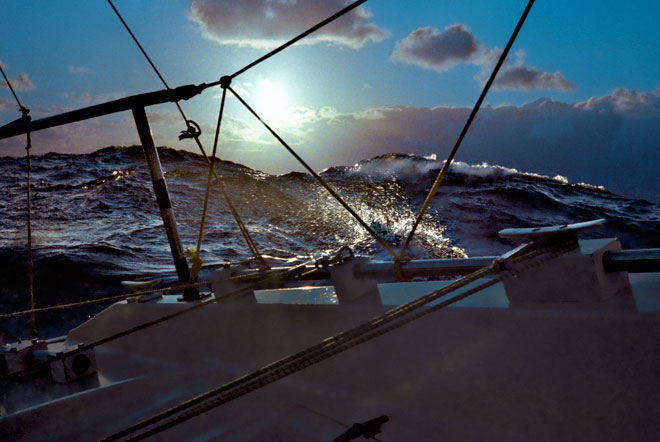
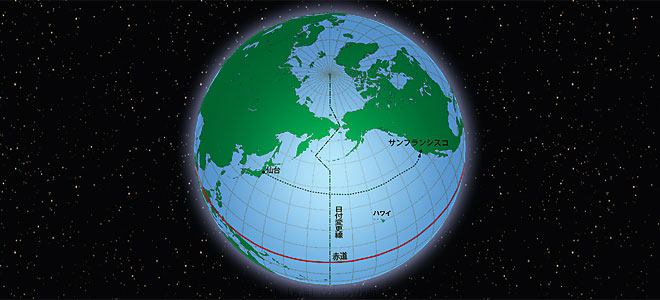
Hints for Safe Sailing
故障により安全が脅かされ、あるいは航行に支障が出る装備品は、充分な予備を持つか、修理の技術や道具を整えておくべきである。そのような準備と心構えがないまま、装備品(エンジン、電子機器等を含む)に頼る行為は、非常時に致命的な結末を招くことがある。
EXPLANATION

Japanese sailing magazine KAZI
いよいよ太平洋横断の航海です。
「いよいよ」と、あえて表現したのは、それなりの理由があるためです。
私が日本を出て、太平洋を横断し、北米に着き、
さらに南下してチリ多島海を通り、
ホーン岬から大西洋に入り、アルゼンチンに着き、
そこから南極に行き、大西洋を渡ってアフリカに着き、
後に長い長いインド洋を渡り、
オーストライアン・バイト(Great Australian Bight)も渡り、
シドニーから太平洋を縦断して日本に帰った
――――と長々説明しても、一般の人やヨット乗りに分かってもらえるのは、せいぜい太平洋横断くらいかもしれません。
南極航海も、チリ多島海も、なんのことかよく分からないけれど、太平洋横断なら分かる気がする。というのが、実情だろうと思うのです。
世界一周航海の体験者から見れば、もしかすると太平洋横断は初心者コース、腕試しの航海かもしれません。
実際、私の場合で恐縮ですが、難易度に点をつけるとすれば、太平洋横断が1点、世界一周が3点、チリ多島海は5点、南極は10点、という感じでした。もちろん、ヨットの大きさや装備、航海情報や前例の有無、時代や運や資金の額や友人の差違により、難易度は大きく違ってきます。あくまでも私の場合に限った点数です。
とはいえ、これは日本に帰ってからの採点であり、実際に太平洋横断中は、間違いなく10点と感じていたのです。
では、いったい何が大変だったのでしょう?
六分儀でヨットの位置を求めることでしょうか?
嵐のとき、帆を縮める作業でしょうか?
波で大揺れの船内で、食事を作ることでしょうか?
孤独との闘いでしょうか?
本当につらかったのは、私の場合、船酔と嵐に対する恐怖感でした。
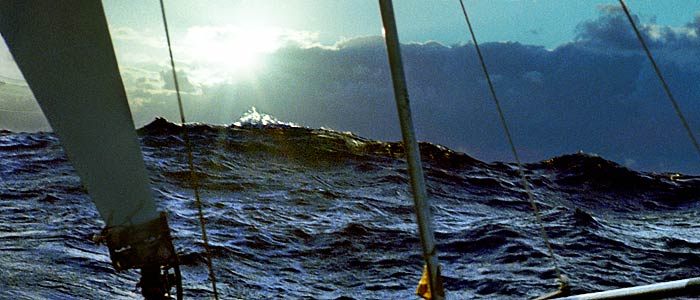
日本でヨットに乗っていたとき、船酔などしませんでした。いや、本当は少し船酔したのですが、わざと平気な顔をしていたのです。そして実際、ヨット仲間の友人たちと比べれば、確かに船酔には強いほうでした。
ところがどうでしょう。陸を離れて太平洋に出ると、船酔で寝込んでばかりです。風が強まって帆が破れそうになっても、帆を縮める気力もないし、もちろん食事の用意をする元気もありません。こんな事ではだめだと思うのですが、どうしても気力が湧いてこないのです。
そして、嵐が怖くてたまりませんでした。まるで嵐の影におびえて暮らすようでした。いつ、次の嵐が来るのか、そればかりを気にしていたのです。
こんな事で、本当に太平洋を渡ることができるのでしょうか? 自分には、その能力があるのでしょうか? 先は全く見えませんでした。
*
太平洋横断について、一般の人からよく質問されるのは、食べ物についてです。
「冷蔵庫はあるんですか?」
小さな貧乏ヨットに、あるわけないでしょう。だいいち、電気どうすんですか。
「じぁあ、食品の保存は? 宇宙食みたいなの食べるんですか?」なんて聞かれることもあります。
でも、スーパーに行けば、1年以上も保存できる便利な食品がいくらでもあります。やはり代表的なものといえば、缶詰でしょうか。レトルト食品も手軽に入手できます。そして経済的に余裕のある人なら、登山用品店などにフリーズドライの食品も並んでいます。
海外では、日本であまり見かけない野菜の缶詰なんかもありました。らっきょうとか椎茸とか、たしかタクアンや奈良漬けなんかもあった気がします。

でも、これって何か変ですよね。こんな現代的なものを食べないと、大海原を渡れないのでしょうか?
いったい、昔の人達は、何を食べて航海していたのでしょう?
冷蔵庫に入れない卵が、どれくらい持つか知っていますか?
ジャガイモやキャベツはどうでしょう。
果物は長持ちするのでしょうか?
肉はどうして保存するのでしょう?
こんなことは、数万年前の原始人だって、おそらく知っていたことです。
なのに、我々の多くは、ほとんど知らない。
ただ賞味期限のラベルを見ている。
自分の感覚や判断を頼らずに、与えられた情報の中で生きています。

タマネギは、長持ちの代表選手です。網袋やカゴに入れ、風通しのよい場所に保存すると、数か月以上も持ちました。ただし、乾燥状態のよい物を選ぶこと、また国によっては長持ちしない品種があるようなので、注意が必要です。
オレンジも、タマネギと同様、驚くほど長持ちしましたが、これまた品種によっては要注意です。
ニンジンは、長持ち野菜の仲間ですが、実はクセモノです。何年も航海を続ける間、色々と試行錯誤を重ねたのですが、風通しのよい場所に置くより、なんとポリ袋に密封した方が長持ちしたのです。これはアフリカのマーケットで、黒人のオバサンに教えてもらいました。初めは半信半疑だったのですが、実際に試してみると、実に効果的なのです。密閉しなかったニンジンは黒く変質しても、ポリ袋に入れたニンジンは少しフニャフニャにはなりましたが、まだまだ大丈夫でした。新聞紙を一緒に入れておくとよいようです。
それなら、卵はどうでしょう。カラのまわりにワセリンを塗り、呼吸を止めると、長持ちすると言われています。実際、室温20-25度程度で、3週間ほどは持ちました。残念ながら、冷蔵庫で卵がどれほど持つか、試したことはないのですが。
また、南極で会ったフランス人から習ったのですが、熱湯に5秒間だけ漬ける方法もあります。カラの内側に薄い膜ができ、これまた呼吸を止めるらしいのです。 やってみましたが、ワセリンに比べ、どれほど効果的かは分かりませんでした
(航海中の食品保存法について、よい方法や体験談をお持ちの方は、ぜひお教えください。御連絡をお待ちします。)
*
ところで、太平洋横断といっても、どんなコースを進むのでしょう? そして夏と冬では、どちらがよいのでしょう? それとも、そんなことは、どうでもよいのでしょうか?
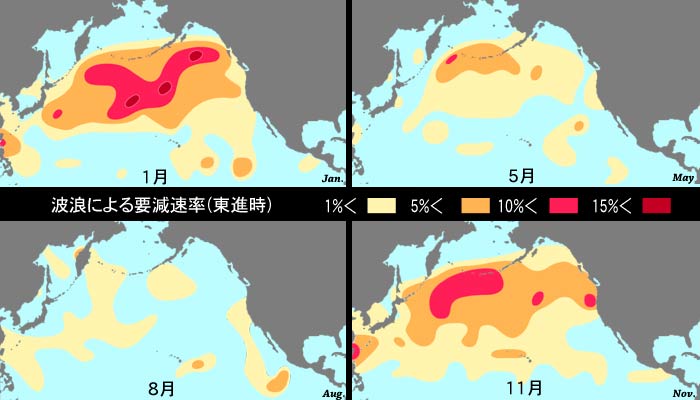
この図は、季節による海の荒れ方の目安を示したものです。
詳しく言うと、太平洋を東進する際、波浪により船舶の速度を下げて航行する場合の率です。(Ocean passag for the world掲載資料より作成)
もちろん、東進、西進、南進、北進、それぞれで結果は違ってきます。今回は日本からの太平洋横断ですから、東進の場合に当たりますね。
これは大型船舶用の資料ですから、苦手とする波やうねりの波長が小型ヨットとは異なるため、そのまま当てはめるわけにはいきません。波長の短い波、たとえば波長10メートルの波は、船長10メートルの小型ットにとっては問題ですが、船長100メートルの大型船舶にとっては、たいしたことではないでしょう。 逆に、波長100メートルの波は、船長10メートルのヨットにとっては、船体がゆっくりと上下するだけですが、船長100メートルの大型船にとっては問題な場合があるでしょう。
とはいえ、小型ヨット用の資料はありませんし、海の荒れ方の一応の目安となりますから、この図で考えてみることにしましょう。
まず気がつくのは、夏と冬でかなり状況が違うことです。図上で色が濃いほど、 海が荒れるというわけですから、航海するなら夏がよいように思えます。でも、あくまでこれは平均値のデータです。夏には台風のリスクがあることを考慮しなくてはなりません。
また、図を見ると冬の航海は大変そうですが、南の方を通ればリスクはかなり減りそうです。ただ、風向を考慮する必要があります。
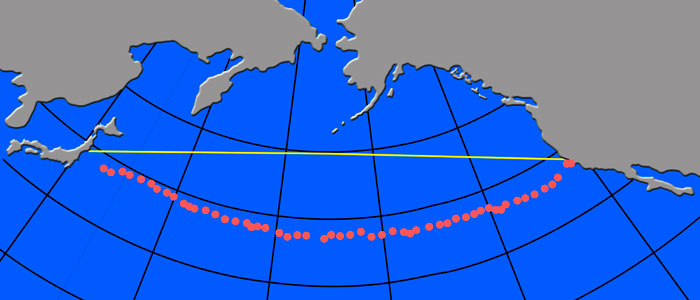
この図は、<青海>の太平洋横断中、約2か月間の位置を、日ごとにプロットしたものです。(出発後数日間のデータが抜けています)
黄白色の直線は大圏航路で、およそ8000kmあります。赤点の列が実際のコースで、ぼぼ北緯38度線上ですから、遠回りしていますね。 北の大圏航路を通ると近道ですが、嵐の率も増えそうなので、このコースを妥協点としたわけです。
赤丸の間隔を見ると、接近している時もあれば、離れているときもありますね。向かい風だったり、たまには凪で進まない日もあれば、追い風に押されて驚くほど走った日もあります。太平洋横断中、約2か月間の平均は、1日75マイル、約140キロでした。もちろん、これは24ftの<青海>の場合です。
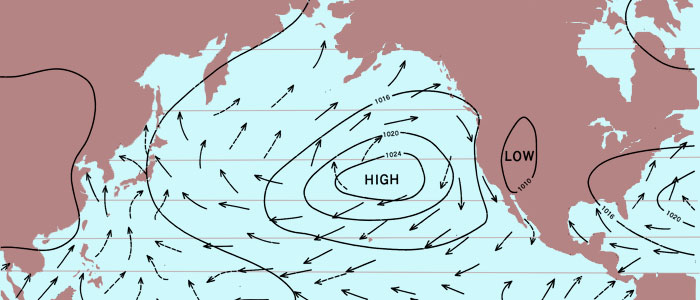
この図は、夏(7月)の風向です。海上保安庁の大洋航路誌付図より作成しました。これを見ながら、追い風になるようにコースを選べばいいですね。でも、あくまで平均の風向ですから、いつもこの通り吹いているわけではありません。特に偏西風帯では、風は日々刻々と変化していきます。また、年によっては、これとは大きく違うこともあるでしょう。あくまで平均ですが、コース選びには参考になるかもしれません。
とはいえ、平均寿命を信じて人生計画を立てても、早く死んだり長生きしたり、平均なんて個々のケースでは、もしかすると無意味かもしれませんね。
Back to main page.